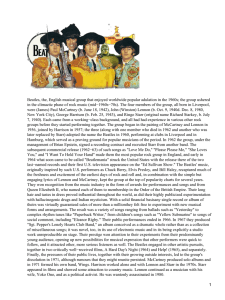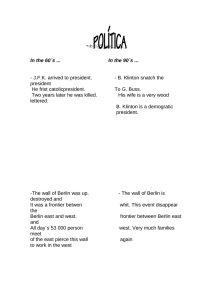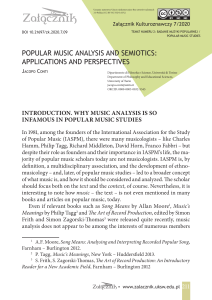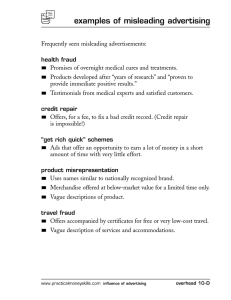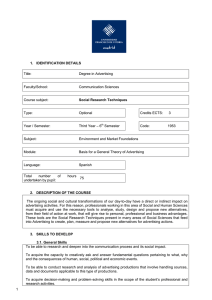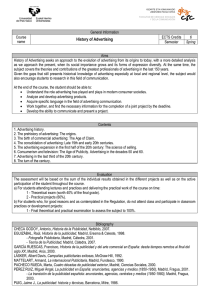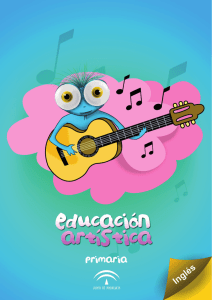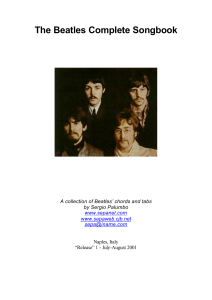Influence of The Beatles` musical rhetoric - E
Anuncio
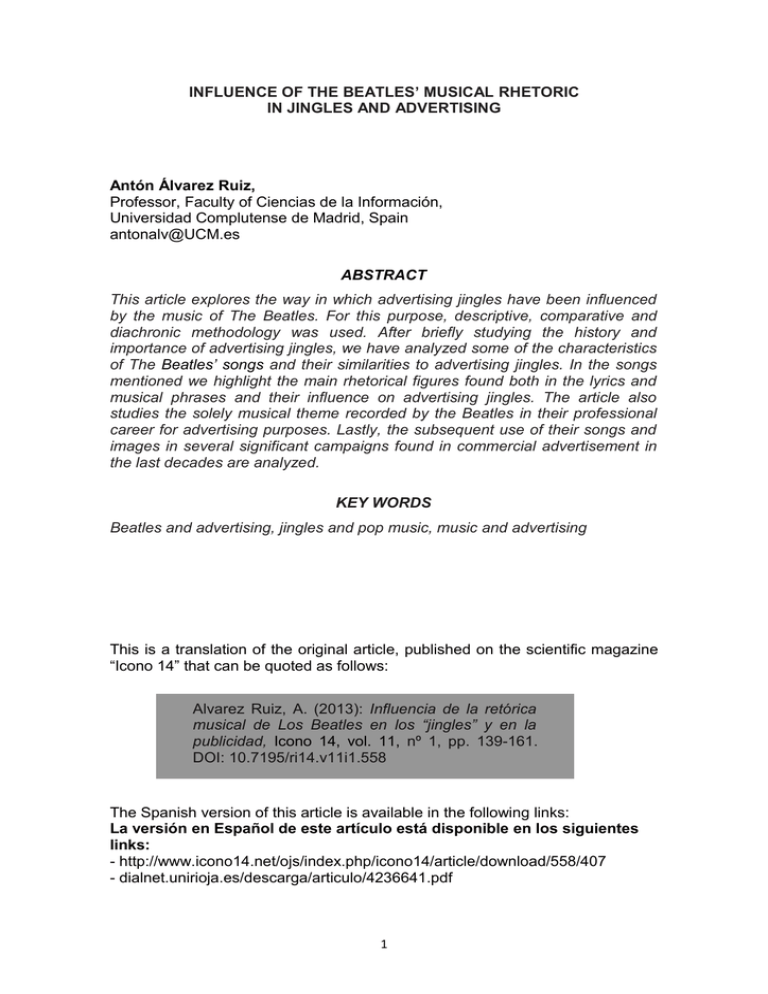
INFLUENCE OF THE BEATLES’ MUSICAL RHETORIC IN JINGLES AND ADVERTISING Antón Álvarez Ruiz, Professor, Faculty of Ciencias de la Información, Universidad Complutense de Madrid, Spain [email protected] ABSTRACT This article explores the way in which advertising jingles have been influenced by the music of The Beatles. For this purpose, descriptive, comparative and diachronic methodology was used. After briefly studying the history and importance of advertising jingles, we have analyzed some of the characteristics of The Beatles’ songs and their similarities to advertising jingles. In the songs mentioned we highlight the main rhetorical figures found both in the lyrics and musical phrases and their influence on advertising jingles. The article also studies the solely musical theme recorded by the Beatles in their professional career for advertising purposes. Lastly, the subsequent use of their songs and images in several significant campaigns found in commercial advertisement in the last decades are analyzed. KEY WORDS Beatles and advertising, jingles and pop music, music and advertising This is a translation of the original article, published on the scientific magazine “Icono 14” that can be quoted as follows: Alvarez Ruiz, A. (2013): Influencia de la retórica musical de Los Beatles en los “jingles” y en la publicidad, Icono 14, vol. 11, nº 1, pp. 139-161. DOI: 10.7195/ri14.v11i1.558 The Spanish version of this article is available in the following links: La versión en Español de este artículo está disponible en los siguientes links: - http://www.icono14.net/ojs/index.php/icono14/article/download/558/407 - dialnet.unirioja.es/descarga/articulo/4236641.pdf 1 INTRODUCTION AND OBJECTIVES In this article we want to examine how the rhetorical figures present in the The Beatles’ songs have influenced advertising jingles. We know that rhetorical figures are present in both popular and classical music from its origin. But the fact that The Beatles did an extensive and focused use of these figures along with the fact that jingles tried to achieve a similar effect to facilitate remembering and linking brands to consumers has enabled convergent spaces between the two activities, promoting their influence. Also, we wanted to analyze certain relations between pop music and advertising and, by extension, the rhetorical significance of the presence of celebrities of pop and rock in persuasive communication. METHODOLOGY We have used a markedly qualitative approach, following an analytical, descriptive and evolutionary process which we believe is demanding for the topic addressed. To do this, we first studied the history and evolution of advertising jingles which have also been used by almost all the songs of The Beatles. We have selected for comment the songs that presented common rhetorical devices with jingles categorizing them based on their rhetorical expressions. In a subsequent level, we have observed the incorporation of songs by The Beatles and other great artists in advertising campaigns for highpublic impact –which occurred precisely when jingles were beginning to be replaced by original tracks– analyzing the mutual interrelations created. We also notice the rhetorical and communication effects achieved when groups and singers where incorporated on advertising campaigns. 1. EFFECTIVE SUPPORT FOR ADVERTISING The jingles are one of the many original elements that were created by the advertising industry. Those simple and very catchy songs achieved that the name, slogan and product benefits were recorded in our memory persistently, sometimes even against our will, and oriented in a certain direction our consumption tendencies. Technically, we can define the jingles as “a piece of music composed to accompany the advertisements which is characterized by being short and easy to remember (Hoyuela and Lázaro, p. 142). It is striking 2 that, despite its widespread use and popularity they have attracted so little musical and critical studies by experts (Fernández Gómez 2002, p. 401; Sala, p. 12). And, although some experts have appeared lately writing on the subject, these are mostly involved in sorting jingles based on their different types and uses instead of analyzing what we believe would be more interesting such as its function, its contents or its proposed rhetorical figures. Perhaps the jingles have not drawn special attention from researchers in persuasive communication because music often plays an important but inconspicuous role (Sánchez Guzmán, p. 173). So when we witness an audiovisual piece, we see the image with greater intensity than the soundtrack. And when we listen to a piece of audio we tend to project our attention to the text rather than the music. Although in recent decades the use of jingles themselves is losing ground to the use of original songs and versions (Espadalé, p. 289), they have played for almost a century a very important role in the advertising business for their ability to raise brand recall and the properties and values of the brand (Ferrer, p. 160; Sala, pp. 12 and 43). By combining the "three Rs" –rhythm, rhyme and repetition– higher levels of memorization are achieved than without music (Palencia-Lefler, p. 93-4), that is why nine out of ten audiovisual advertisings use music (Espadalé, p. 289). The jingles appeared with the commercial radio at the beginning of the 20s (Wikipedia, 2010) proving once again the facility to filter advertising in new media and communication channels. And in those first years of history of radio advertising it was quickly discovered that the messages that were placed on a song were much more effective than those that were simply read by the announcers. 2. WHEN MUSIC IS THE SOUL OF THE BRAND Over time, the jingles and other advertising melodies have evolved significantly producing in them a marked process of creative styling. And the jingles have committed to such a level with the image of some brands that they have become a substantial part of the values the brands promote (Aizcorbe, p. 10). The campaign considered the most successful in the history of advertising and withholds the record for duration is Marlboro cowboys created by the agency 3 Leo Burnett in 1954 (Souter and Newman, p. 234), was supported since its inception in the brilliant soundtrack of “The Magnificent Seven" by Elmer Bernstein (Sturges, see Graph No. 1). His evocative music helps to visualize the world of freedom and ruggedness of cowboys, erecting a central pillar in the construction of the imaginary of the brand (Marlboro 1963), and has been the subject of some specific advertising campaigns made by the brand itself (Marlboro 1967). Graph No. 1. The Magnificent Seven’s tune has become part of the Marlboro’s brand character (image retrieved 3/January/2014, 20:00 h. from http://rdd.me/v7xdko9p) In Spain, we find a comparable case in terms of ownership and durability: the jingle of ONCE (Spanish National Organization for the Blind) called “La ilusión de todos los días” (“The excitement of every day"). It was released for the first time in 1983 (Álvarez. p. 91, ONCE) and the jingle is a substantial part of the popular and positive character of the brand, especially in the radio. The musical theme of ONCE –which, like that of Marlboro, is what is called "musical 4 logo" or "corporate tune", because the audience only needs to hear a few notes to remember immediately the advertised brand– has been used for decades until today, updated regularly with different arrangements, and has surpassed the most remembered jingle in our country according to the experts: the famous song "Yo soy aquel negrito" of Cola-Cao, –a brand of soluble chocolate drink– that appeared in the late 50’s and reached a very high reputation in the next decade (Summers, pp. 33-34; Palencia-Lefler, p. 90; Cola-Cao). Graph No. 2. For decades the most remembered jingle in the Spanish advertising was the song of Cola-Cao, a very popular soluble chocolate drink, now available from Chile to China (image retrieved 3/January/2014, 20:30 h. from http://rdd.me/4v51vhqs In their performance, as modest as effective, jingles rely on the simplicity of the music and lyrics to achieve an easy to remember melody as we have already mentioned (Lorente, p. 109) and, from a very basic scheme of composition, speak a direct and close language that quickly connects with the audience because it uses the same codes of the people targeted (Fernández Gómez, Muela, p. 195). Surely this immediacy is its main quality, which facilitates the recall of the name and brand properties associated with a contagious musical phrasing. 5 3. THE JINGLES IN THE TV AGE In the late '50s and early '60s, when television experienced a rapid expansion, the jingles were popularized in this new medium, reaching remarkable heights of perfection and increasing its effectiveness. Now that advertising music had the opportunity to work with the visual image a new era in commercial persuasion began. It offers more elaborated and attractive pieces intensively exploiting the combined audio and video resources. It was also during this time that an English music group called The Beatles began to become very famous, composing a type of very personal, straightforward rock, supported by bright, catchy melodies. Besides many other musical influences, it is clear that the songwriting of The Beatles was initially influenced by advertising jingles. And indeed, some members of the group have repeatedly admitted that they obtained the inspiration of what surrounded them, using techniques such as browse newspapers and TV, listen to the radio or watch advertisings (The Beatles, 2000, p. 97), as it occurred with other musicians of their time trying to get in this way a more casual approach to musical composition (Miles, p. 71). Other great figures of the popular song contemporary to the Beatles as Paul Simon or U2 later have incorporated known slogans in advertising campaigns for some of their songs criticizing consumerism ("The Big Bright Green Pleasure Machine" Simon, 1966 "Zooropa" by U2, 1993). Therefore it seems justified to assume that advertising jingles influenced The Beatles’ rock music and could help prepare its evolution towards pop music, which would be their greater contribution to the history of popular music. But what we think is totally unquestionable, even though we have never seen it mentioned, is the influence that the Beatles themselves had on advertising jingles. And we believe that’s why it is so easy to find a large variety of common places between jingles and The Beatles’ songs, especially if we rely on the rhetorical devices used in both musical discourses, as detailed below. 6 4. THE JINGLES AND THE BEATLES: INFLUENCES AND MEETING POINTS 4.1. Optimistic tone Like a good jingle, The Beatles’ songs show a lively and dynamic tone. Maybe this feature is one of the most significant elements of The Beatles’ songs as this group knew how to make their songs convey a high dose of confidence, as do products and well established brands. One of their first hits, “Please, Please Me” offers a good example. Also songs like “I feel fine" or “Drive my car" transpire this contagious optimism that allows them to connect with the public and become familiar quickly, which is an effect searched by the music of any brand. 4.2. Condensed melodies The early Beatles songs are simple, short and blunt; musically are pretty condensed and concentrated in a few melody notes. Enter directly into the musical theme and then go to the chorus without further detours. This procedure raised the essential theme tune. This allowed The Beatles to explore in song quite original technical solutions for its time as starting right into the chorus, which occurs in “She Loves You", "Strawberry fields forever” or "We Can Work It Out". Both features used to condense the melody and gain direct access to the catchiest theme properties are commonly found in all good advertising jingles. 4.3. Bright starts, round ends Special mention should be made to the beginnings and endings of songs, two parts which are usually carefully crafted around a jingle. Following the same criteria, once composed the melody, The Beatles worked under the musical background of the beginning and end of each song to make them more stylistically clean and neat. Many of their songs could serve as an example of this feature, but perhaps the most successful in this regard is "Help!" If we look at the beginning (see The Beatles, 1965, from 0:0 to 0:08, see the lyrics in the Table No. 1; see 7 also Graph No. 3) we can observe a strong and striking boot prepared to catch the attention of more indolent listeners. Graph No. 3. In addition to other musical innovations, the theme “Help!” shows a brilliant start and a remarkable end (image retrieved 3/January/2014, 22:00 h. from http://rdd.me/aqkfaclf) And then we can pay attention to the end (The Beatles 1965, from 2:01 to 2:10 see, letter in the Table No. 1). If the start of the song is already remarkable, the ending is really brilliant: during the song, the rhythm is quite fast, but the final few seconds it slows down and ends up leaving a kind of vibration in the air that extends subjectively the real duration of the song. This resource is also very sought after by jingles to dilate their effectiveness and subjectively stretch the duration effect. Also, round ends of this type can be found in other songs such as “Eight days a week", “Penny Lane” and “Lady Madonna". They assumed an important musical innovation and a sample of the creative restlessness of The Beatles in an era in which it was usual to finish repeating the song’s chorus several times while the volume turned down in the foreseeable fade out procedure. 8 Table No. 1. “Help" Start of the song Help!, I need somebody, Help!, not just anybody, Help!, you know I need someone…. Heeelp! End of the song Won’t you, please, Please, help me? Help me, help me-ee, uh-uh 4.4. Repetitions and other rhetorical figures Both jingles and The Beatles’ songs have deployed a wide repertoire of rhetorical devices, repeatedly applying a number of figures of the orthodox oratory developed and classified in classical Greece. Repetitions are the most used rhetorical device, not only in the text but –and especially– in musical phrases. No doubt that the repetition –called ostinato in the cult musical language– is the basis of rock and pop. This characteristic, in large measure, makes the songs of these genres so easy to listen and retain properly, and are commonly referred to with the expression “is a catchy song”. But this stylistic device with The Beatles reached a particular virtuosity in a large number of parts, as it can be seen by reviewing the excellent riffs of songs like "I Feel Fine", "Day Tripper", "And your bird can sing", "Paperback writer", "Ticket to ride" or "Drive my car". In addition to its purely musical functions, the use of repetition makes the public memorize at least a significant part of the songs practically during the first audition. Just as jingles repeated several times the name of the advertised brand, slogan or principal benefit, The Beatles used to repeat the title of the song several times –sometimes at the beginning of the song by using an anaphora or repetition, as in the case we've seen of "Help"– or more frequently at the end of the theme to facilitate recall. At other times, the repetitive resource used to close the song was used to recall the phrase from the start, closing the circle, as in “Eight days a week" and “Eleanor Rigby”, which together constitute clear examples of musical epanalepsis. The latter song also offers two separate 9 samples of hypotyposis and etopeya applied to Eleanor Rugby and Father McKenzie, to whose lives the lyrics refers. Sometimes repetition involves a more original intent and effect, as in "I wanna hold your hand". The phrase "I can not hide, I can not hide..." is heard several times in succession, providing a subtle paradox that plays with the audience and stimulates their interest in giving the impression that the disc was scratched and has entered in a loop, something very common in the days of vinyl discs. Puns and double reading expressions, especially the antithesis and homonyms were also widely used by The Beatles (Dister, p. 17 and 24, Miles, p. 75). We can start by minding the name of the group that offers an ingenious example of paronomasia because, regardless of the primary meaning ("The Beatles”) contains another mocking sense suggested by their sound ("The Beetles") (Dister, p. 26). We might also note that "The Beatles" is a very apt name for a band: it is an excellent product designation which meets most of the requirements that are required of a brand in naming tests: is euphonious, short, memorable, easy to pronounce, explanatory, descriptive, easily convertible into logo (see Graph No. 4), etc. Graph No. 4. The famous logo with the dropped "T", used in the early days of the group and designed in 1963 by Ivon Arbiter and Eddie Stokes, underlines and reinforces the existing paronomasia in the name (Source: The Beatles Bible). Besides the name and logo, many other actions of the group could be classified as shining examples of advertising communication and conscious use of media with a persuasive purpose: their image with fringes, the albums’ cover art, the clothing used, the press conferences –excellent public relations 10 exercises– the initiative to make films and music videos, the international broadcast of the recording of a song that became instantly famous ("All you need is love"), etc. But delve into these fields far exceeds the purpose of this writing. Some songs contain remarkable examples of rhetorical figures in the titles and in the text, but they always keep the level of simplicity of the rest of the lyrics to allow the general public to understand, regardless of their cultural level, as it occurs with the oxymoron of “Please Please Me” and “A Hard Day's Night", in the first combo case with alliteration and secondly with an antithesis. We also found a sustained hypotyposis in the cheerful and lively description of the people who live on the alley Penny in "Penny Lane", whose lyrics are full of fun licenses, a striking paradox in "Eight days a week" (The Beatles, 2000, p. 159) or a business paronomasia in the chorus of "She's living home" when the text weaves figuratively the daughter’s run away from home and the reproaches of her parents, creating a kind of conversation between musically deaf in the passage called "Greek chorus" (see McCartney, from 1:06 to 1:20, lyrics in the Table No. 2). Table No. 2. Greek choruses of the song "She's living home" (fragment) Parents: – …We gave her everything money could buy. Daughter: – Bye, bye… Source: McCartney These phrases played with the phonetics of the words “buy" and "bye” that sound exactly the same. It is likely that this song would inspire an advertising campaign in the London airports in the late 80’s when some posters using large letters simply said “Buy, buy” (and obviously suggesting "bye bye”) were duly signed by the Duty Free Shops at the airport itself. These Greek choruses also offer a continued example of antithesis. In the song “Girl" we find some double meaning jokes perfectly set for the attentive listener. First, if you pay attention to the vocal accompaniment of the 11 musical variation, neatly sang in three voices, you can distinguish that it says "tit, tit, tit..." instead of the usual "dit, dit, dit…" (The Beatles, 2000, p. 196; Fontenot, 2011). Secondly, we can hear the sound of suction on the chorus after the word in the title of the song that many listeners interpreted at the time as a sigh of desire. But this stylistic device, which was conveniently emphasized in the mix of the song, could be prepared by The Beatles as an undercover message for joint smokers –in fact it sounds like a strong aspiration given to a cigarette– at a time this activity began to be seen as a symbol of the emerging counterculture, thus establishing a possible generational identification between the Beatles and their fans (Fontenot, 2011). 4.5. Formal finish and innovative technical solutions Finally, The Beatles carefully worked the melodies, arrangements and explored alternative solutions to enable them to find the best option (The Beatles, 2000, p. 175) and they cared extremely about the final execution, looking for a perfect trim level, as often do composers, arrangers and producers of advertising jingles. With these and other rhetorical and musical resources, The Beatles managed the involvement and complicity of the listeners, arousing interest and trying to create surprise, as the jingles tried to do. Perhaps this explains, to some extent, the huge commercial success of the group and the long life of their songs, generation after generation. Meanwhile, some authors have noted the similarity between the jingles and pop music, highlighting the pleasant character, simple and close to both musical genres (Fernández Gómez, 2008). In addition to the purely musical and rhetorical questions, The Beatles introduced technical solutions then applied on advertising, such as compression of the sound edition. Thus, in the LPs "Revolver” and "Sgt Peppers" the group decided to significantly compress the final sound edition to give brightness and clarity limiting the deep tones (The Beatles, 2000, p. 206). This process was later used in the campaigns of radio and television to increase the volume of advertising pieces without distorting the content and is responsible for advertising breaks to have an emission volume significantly higher than the rest of the programming in our country. 12 5. ADVERTISING THEIR OWN SONGS The Beatles never explicitly created music for advertising campaigns. The only initiative that can be considered similar to that was a version that was made for "From me to you ", a program of the British public broadcaster BBC. The song was their third single as a group and their first number one in the official list of British sales, Record Retailer. To do this, they selected the initial verse of the song and changed the wording of the penultimate verse (“with love from me to you”, see Table No. 3A) which was replaced by "with love from us to you” incorporating the program name (“From us to you”) in the version which was broadcasted. The opening song lasts for 1:56, while the new version was trimmed to 0:27. Table No. 3A. Original chorus of “From me to you" Da-da da, da-da da, da da (bis) If there's anything that you want If there's anything I can do Just call on me and I'll send it along With love, from me to you To you, to you, to you. Source: The Beatles, 1994 This version seems to have been the result of improvisation, which would be another demonstration of the versatility, ingenuity and creativity of the group. We can say that, as a piece of communication, it constitutes simultaneously a promotion of the radio program, the song used and the Beatles themselves, when they needed to stand out because the social phenomenon of “Beatlemania" was still forming. The piece was recorded on February 28, 1964 and aired on the program “From us to you” repeatedly between March and the summer of the same year (Wikipedia, 2011). From a formal point of view, this topic serves perfectly as a jingle and fulfills, to our knowledge, all the requirements that define this type of advertising pieces, confirming the relationship of form and content that we have established above between jingles and a number of significant issues of the Beatles. 13 This version of "From me to you" can be heard on the compilation album "Live in the BBC" (see The Beatles, 1994). On the CD this song is in the second place, preceded by a "self-presentation" officially called "Beatles Greetings" which the Beatles had recorded previously also in the BBC on October 9, 1963, and was broadcasted on the program "The Public Ear" on the 3rd of November of that year (Wikipedia, 2011). It is very striking the significance that these recordings acquired when played straight, as on the CD, and it is not at all accidental that they were located in such an order to open this wide selection of songs from the group's beginnings. First, in the recording “Beatles Greetings", the four Beatles presented themselves (see Table No. 3B) giving their name and explaining the instrument they played. Table No. 3B. Text of the first two songs of "Live in the BBC" Ringo: Paul: George: John: I'm Ringo and I play the drums. Hey... I'm Paul and I play the... hum... bass. I'm George and I play a guitar (whistle). I'm John and I play guitar too... Sometimes I play the fool. The Beatles: Da-da da, da-da da, da da (bis) If there's anything that you want If there's anything we can do Just call on us and we'll send it along With love, from us to you To you, to you... Source: The Beatles, 1994 They do so by appealing to humor and naturalness –Paul McCartney doubts when speaking, behind vocals a whistle is heard, John Lennon makes an ironic play of words– showing the same casual style that they later would exhibit in their famous press conferences (Miles, p. 47-69). It is ironic to think that shortly after and based on the level of popularity that the group would reach globally, a presentation of this type would be entirely superfluous. This would lead them to edit the first album released in history –"Rubber Soul"– that did not show on the cover the name of the band1 (Freeman, pp. 62-64). 14 Following this introduction the new version of the song analyzed before “From me to you" and both musical pieces together –“Beatles Greetings" followed by "From us to you"– recreate what could have been a perfect 41 seconds long advertising spot of the band and reveals the values that the separate recordings have as parts of commercial promotion and persuasive communication, very ahead of their time. We should mention that the application using the chorus of a song partially changing the lyrics was later copied numerous times. In Spain, during the 80’s different groups and successful singers often used it to auto-promote their songs in “Los 40 Principales" (The local Top Forty). 6. PRESENCE OF BEATLE MUSIC ON REKNOWN CAMPAIGNS Although their ideas and music were widely imitated in the sound production of advertising campaigns, The Beatles never allowed licensing the copyright of their songs or image for use in advertising campaigns, following the same criteria as other great artists of their time. Bob Dylan, for example, had repeatedly expressed his refusal to such actions, despite having millions in deals, but later appeared in an advertising for the Cadillac cars (Wheaton) and promoted Zaragoza World Expo held in 2008 (Dylan, 2007 and 2008). This situation underwent a drastic change when the renowned singer and songwriter Michael Jackson bought the rights to the songs of The Beatles in 1985 (Crawford) and began licensing his copyright for advertising purposes to recoup this investment. Spain was one of the first countries to take advantage of it, using Beatles’ songs in a brand campaign of soda Kas –part of the PepsiCo Inc.– by Danis Benton & Bowles advertising agency (now part of Leo Burnett Worldwide). Shortly after, a cover of "Imagine" lent their music to a commercial of Rank Xerox ("Imagine a world without problems") made by the Spanish agency Contrapunto (today part of BBDO Spain) and awarded in several international advertising festivals. Similarly, a U.S. campaign of Nike used the original song "Revolution" in 1987, taking advantage of a loophole in legislation (see Nike 1987) against the express wishes of Yoko Ono, the person holding copyright of the songs of John Lennon. Later, that same brand used the original version of "Instant Karma" in a 15 campaign by Wieden + Kennedy agency (see Nike 1993) but this time with the permission of Lennon's widow. Also, Yoko Ono personally negotiated the use of Lennon’s song "God" (Espadalé, p. 289) for a campaign of the car Golf in Spain by the agency DDB Barcelona in 1998 (see Golf, 1998). The message of this campaign can be read in Table No. 4. Table No. 4. Full text of the Golf’s campaign with some verses of “God" John Lennon: I don’t believe in Elvis I don’t believe in Kennedy I don’t believe in Beatles I just believe in me Announcer: And you? Do you believe in Golf? These facts allow us to ensure that, over time, the music of The Beatles did not just affect the characteristics of the advertising music production but even supplanted it precisely at the time when jingles were beginning to be replaced with original songs, covers or versions, as mentioned before (Espadalé, p. 289). This occurs at a recent campaign of Movistar, which uses a version of the jingle "Come together" by Lennon: users of that phone operator interpret the jingle with the sounds of their mobile phones (see Movistar 2012). CONCLUSION In this essay we believe we have demonstrated the influence and the clear linkage that the musical production of The Beatles has had on advertising jingles, thanks to the analysis of rhetorical figures present therein. We have also analyzed the unique composition made by this group intentionally with advertising purposes. We have also detailed some water transfers between popular music and advertising activity; briefly analyzing the individual cases offered by artists and campaigns. This has allowed us to understand better these connections, but it also 16 opens other routes of discussion on a topic of considerable social significance. Although it has been studied, it is far from exhausted and comprises important semiotic considerations. We refer to the transfer of values between popular music, idols and advertising campaigns and other actions of persuasive communication. DISCUSSION. FROM THE USE OF MUSIC TO THE SEMANTIC APPROPRIATION OF THE IMAGE Exceeding the mere use of music, in more recent times we have seen the use and exploitation of the imagery of The Beatles by advertising campaigns. The "Think Different" campaign (see Apple, 1997), developed for Apple by TBWA/Chiat/Day agency and recognized with major awards worldwide for its strategic and creative approach, showed John Lennon accompanied by Yoko Ono during their famous "Bed-In". Graph No. 5. The famous "Bed-In" or protest in bed by Lennon and Ono as a gesture for peace, used in campaign posters of Apple "Think Different”. 17 In the TV commercial, Lennon appeared in a fragment along with other celebrities considered as widely accepted social models whose work and attitude had pushed the establishment to evolve positively. The photographic image of Lennon and Ono deserved a starring role in billboards and outdoor advertising pieces used around the world (see Graph No. 5). In the repertoire of pieces of this campaign appeared other singers from different musical genres, popular and cultured, such as Bob Dylan, Bono (U2), Frank Sinatra and Maria Callas. This stellar use of the most nonconformist member of The Beatles by Apple is perfectly aligned with the strategy of marketing and communications of this brand, positioned at the same time as an heterodox and revolutionary company in contrast with other “conventional” brands, like PC, in the field of computer science and technology. This underlines a fact that, with time, has eventually become obvious: advertising communication has begun to use the music of famous artists and groups not only because of their suitability to musically illustrate certain campaigns or for the intrinsic values they have to promote a particular brand. It has set up a mechanism to take over aspects of the personality of those artists, the values they represent and, by extension, the spirit of the audiences targeted, who accept these artists as a reference. This process involves a mechanism of semantic shift, based on the music, advertising communication has come to use the image and values projected by certain artists, in order to connect and earn the credibility of public followers of these artists because, as we know, the content expressed in an announcement associates its properties to the advertised product (Saborit, p. 89) and finally to the brand. Logically, this is a process generally consented and even led by artists and bands who have found this association, when done correctly, commercially aligning the interests of manufacturers and artists, as a way to increase their popularity and to have an additional channel to spread their music to mass audiences. Undoubtedly, this is an interesting, broad and nuanced topic but challenging to address due to both its complexity and its transversality. It is a debate that is open and where we wanted to provide some elements, as we have seen, based on the popular music and its use by advertising. But we can conclude by adding that this semantic appropriation of the popular and social 18 values and aesthetic embodied by fashion idols is not exclusive of advertising: we can also witness it in political campaigns2 (Berlinger), in professional practice public relations and other activities of persuasive communication. Acknowledgements We wish to thank several advertising professionals and music producers for their documentary support for this article, especially José Carlos Mac of Thebe Mor Creative Studio, Lettoch, Scotland, UK. Notes [1] Robert Freeman, official photographer of the covers of the Beatles from 1963 to 1965, confirmed to the author of this article that both him and The Beatles as he tried to get the group name not to appear on the cover of the album “Help”. They could not convince the record company EMI, but managed to do so in the next album, "Rubber Soul” published just six months later. [2] See at the end of this documentary work, statements of musician Paul Simon on the importance of using popular music celebrities from politicians. Paul Simon supported George McGovern’s campaign in the U.S. presidential election (1972) and positioned against apartheid in South Africa during the tour for his CD “Graceland “(1986-7). REFERENCES Álvarez, A. (2003). La función social de la publicidad de la Once. Madrid, Spain: Escuela Libre Editorial-Fundación ONCE. Aizcorbe, X. (2011). Otros imaginarios, otras músicas. La música en la publicidad: un arma para llegar al alma. Barcelona, Spain: Universitat Abat Oliba-CEU. Retrieved 31/January/2013, 17:30 h. from: http://www.recercat.cat// handle/2072/178859 Apple (1997). Campaign “Think Different”. Retrieved 31/January/2013, 17:30 h. from: http://www.youtube.com/watch?v=4oAB83Z1ydE Berlinger, J. (Director) (2012). Under African Skies. Paul Simon’s Graceland Journey. New York, USA: A&E Indie Films. Crawford, K. (2005). Michael Jackson to lose Beatles catalog? in CNN Money.com, 8/June. Retrieved 31/January/2013, 19 17:35 h. from: http://goo.gl/bUiam Cola-Cao (1956). TV campaign that uses a version of the famous jingle. Retrieved the 17/January/2013, 07:35 h. from: http://goo.gl/2RQIv Dister, A. (1983). Los Beatles. Madrid, Spain: Ediciones Júcar. Dylan, Bob (2007). Advertising campaign for Cadillac Escalade. Retrieved 31/January/2013, 17:30 h. from: http://www.youtube.com/watch?v=9X3Bcmf3ckQ Dylan, Bob (2008). TV campaign to promote the Zaragoza World Expo. Retrieved 31/January/2013, 17:35 h. from: http://goo.gl/FGXrw Espadalé, B. (2000). El sonido de la publicidad, at Moliné, Marçal (editor), La fuerza de la publicidad. Madrid, Spain: McGraw Hill. Fernández Gómez, J. D. (2002). Hacia una funcionalidad de la música en el spot publicitario. Revista Internacional de Comunicación Audiovisual, Publicidad y Estudios Culturales, nº 1. Sevilla, Spain: Universidad de Sevilla, pp. 161-178 Fernández Gómez, J. D. (2008). Música, publicidad y juventud: Sonic Youth, in Etayo, C. and others (editors), Los jóvenes y el nuevo escenario de la comunicación: actas del XXI Congreso Internacional de Comunicación. Pamplona, Spain: Ediciones Universitarias de Navarra-EUNSA , pp. 1-10. Ferrer, E. (1994). El lenguaje de la publicidad. México: Fondo de Cultura Económica. Freeman, R. (1990). The Beatles, a private view. New York, USA: Mallard Press- BDD Promotional Book Company. Fontenot, R. (2011). The Beatles Songs: Girl. The history of the classic Beatles song. About.com Oldies Music. Retrieved 31/January/2013, 17:30 h. from: http://goo.gl/sS74S Golf (1998). TV campaign “God” with the music of the song of John Lennon with the same title. Retrieved 31/January/2013, 17:30 h. from: http://goo.gl/L7v6u Hoyuela, P. y Lázaro, Y. (2003). Diccionario J, Walter Thompson. Comunicación, Marketing y Nuevas Tecnologías. Madrid, Spain: Ediciones de las Ciencias Sociales, S.A. Lorente, J. (1995). Casi todo lo que sé de publicidad. Barcelona: Editorial Folio. Marlboro (1963). Campaign with the song of “The Magnificent Seven”. Retrieved 16/June/2011, 16:00 h. from: http://www.youtube.com/ watch? 20 v=1UQY7srgec8 Marlboro (1967). Campaign promoting a CD with the music of their campaigns. Retrieved 31/January/2013, 17:40 h. from: http://goo.gl/ zP8sf McCartney, Paul (2003). Live interpretation of the song “She’s leaving home” the 24 May 2003 on the Red Square of Moscow. Retrieved 31/January/2013, 17:40 h. from: http://goo.gl/fUkEW Miles, B. (compilator). (1978): Los Beatles vistos por sí mismos. Madrid, Spain: Editions Júcar. Movistar (2012). Campaign “Movistar Fusión”. Retrieved 31/January/2013, 17:30 h. from: http://www.youtube.com/watch?v=VDVC-o4R9NI Muela, C. (2007). La estrategia creativa en la cuña radiofónica con fines sociales. Análisis del mensaje en el medio radio: el contenido y la forma. Revista Creatividad y Sociedad, nº 11, October. Madrid, Spain: ASOCREA. Retrieved 31/January/2013, 17:40 h. from: http://goo.gl/LnPi7 Nike (1987). Advertising campaign with the song “Revolution”. Retrieved 16/June/2011, 14:45 h. from: http://www.youtube.com/watch?v=iMXhtFik-vI Nike (1993): campaign with the song “Instant Karma”. Retrieved 31/January/2013, 17:45 h. from: http://goo.gl/ny0sF ONCE-Organización Nacional de Ciegos (1983). First version of the ONCE jingle. Retrieved 31/January/2013, 17:45 h. from: http://goo.gl/FEHU6 Palencia-Lefler, M. (2009). La música en la comunicación publicitaria. Revista Comunicación y Sociedad, volume XXII, nº 2, pp. 89-108. Retrieved 31/January/2013, 17:45 h. from: http://goo.gl/1yL5a Sala, J. (2009). Del jingle a las canciones pop: una aproximación al uso de la música en la publicidad. Barcelona, Spain: Universitat Abat Oliba-CEU. Retrieved 13/January/2013, 16:50 h. from: http://www.recercat.net/handle/2072/39533 Sánchez Guzmán, J. R. (1993). Teoría de la Publicidad. Madrid, Spain: Editorial Tecnos. Saborit, J. (2012). La imagen publicitaria en televisión. Madrid, Spain: Ediciones Cátedra. Simon, P. (1966). “The Big Bright Green Pleasure Machine”, song from the LP Parsley, Sage, Rosemary and Thyme. USA: Columbia Records-CBS. Souter, N. y Newman, S. (1988). Creative Director’s Sourcebook. London, UK: 21 MacDonald & Co. Sturges, J. (1960). The Magnificent Seven. USA: United Artists. Summers, G. (2000). Yo soy aquel negrito. Los anuncios que marcaron nuestra vida. Barcelona, Spain: Ediciones Martínez Roca. The Beatles (1965) Live show playing the song “Help!” Retrieved 31/January/2013, 18:30h. from: http://goo.gl/KHRXB The Beatles (1994). Song “From us to you” from the CD Live at the BBC. USA: Capitol. The Beatles (2000). The Beatles Antología. Barcelona, Spain: Ediciones B. The Beatles Bible (2011). Retrieved 31 January 2013, 17:45 h. from: http://goo. gl/sAaOI U2 (1993). “Zooropa”, song from the CD with the same name. UK: Island Records. Wheaton, K. (2007). “Bob Dylan Shills for Cadillac”. Advertising Age, 22 of October. Retrieved 31/January/2013, 17:50 h. from: http://goo.gl/7oOOC Wikipedia (2010). Retrieved 31/January/2013, 17:50 h. from: http:// en.wikipedia.org/wiki/Jingle Wikipedia (2011). Retrieved 31/January/2013, 17:50 h. from: http://goo.gl/lLIy9 22
